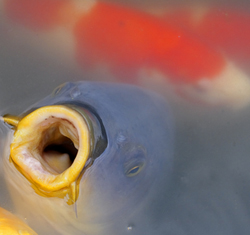
When creating a Koi
pond there are several suggestions that you should take into consideration.
A Koi pond is more difficult to take care of and more costly than
a regular backyard garden pond. The benefits can be more rewarding,
though, if you are a Koi fish lover. If you are serious about having
a Koi pond, then you should be prepared to take the steps that will
maintain a healthy and clean environment for your fish.
One of the most important steps is the type of filtration that will
be used. Though there is controversy over whether straight biological
filtration is better over chemical or a mixed filtration, you will
have to be the best judge of what is good for your fish. It is a good
idea to find other owners of Koi ponds in your local area and find
out how they keep their fish healthy.
For Koi ponds, it is recommended by all to have a good biological
filter. What this basically means is that you need something for the
bacteria to adhere to and enough plants to continue the Nitrogen cycle.
The Nitrogen cycle in its simplest form is started with Koi fish eating
plants and excreting ammonia which is toxic to them. You need ammonia-eating
bacteria to change the ammonia into nitrates which is good fertilizer
for the plants and is non-toxic to the fish. The Koi fish then start
the cycle over by eating the plants for food.
For a good biological filter, many suggest small-sized gravel or
rocks, but larger rocks will work just as well. Think of a riverbed
or stream. There are all types of sizes of rocks and other materials
that the bacteria (algae) can cling to. As in any case, trial and
error on your own Koi pond will help you to make the correct judgment.
For mechanical or chemical filters, you will want to ask the experts
about the types of filters that are best for your Koi pond. Usually,
it is best to use both a biological and mechanical air filter and
pump. The two combined will be more effective in keeping your Koi
pond clean and your fish healthy. Do be aware, though, that a pump
and electric filter running 24/7 will increase your electric bill
by quite a bit. This is why Koi ponds can get so much more costly,
not to mention the purchase price of the fish.
If you are going to have a Koi pond, you want a very large pond.
Koi fish do better in deeper, larger areas. At least 500 gallons of
water and 2 feet or deeper are the best measurements for your Koi
ponds. You should also have straight walls and at least one bottom
drain. A skimmer is also needed to prevent too much debris, such as
fallen leaves, from settling into the pond.
There are many more ideas and suggestions that you will encounter
when planning and creating your Koi pond. Be thorough in your research
and after a while, you will be able to discover what works best for
your backyard Koi pond.